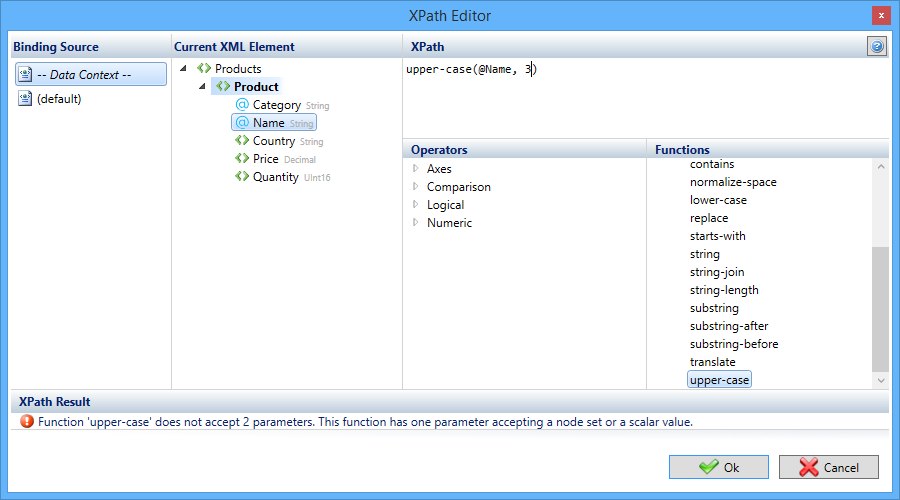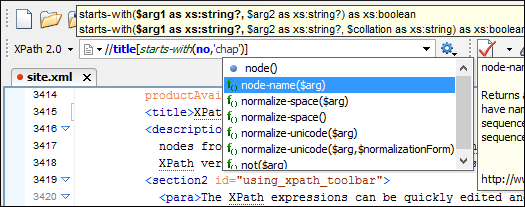Visual Studio Extension Features
Xpath generator 1. Insert your xml in to the big field. To generate an xpath. Place the cursor in the text, attribute or element you want an xpath to. To get started, just click the Show XPath Query Editor button at the top of the XML Editor, or click View XPath Query Editor. Working With XPath Expressions. Using the XPath Query Editor is easy! Just type a valid XPath expression on the Query 1 tab. (This number is incremented for each new XPath query expression you create. So XPath is a generally used query language to extract data (nodes) from an XML document. In Power Automate we can use the XPath function inside a Compose action. For this example, I will be using a part of the sample XML file from Microsoft. XML editor with drag-and-drop to build any XML structure fast and easy. Collapse and expand sections of XML data with a single click. Create XML content in less time with intelligent context sensitive entry-helpers showing elements and attributes from any assigned XSD schema. Xpath generator 1. Insert your xml in to the big field. To generate an xpath. Place the cursor in the text, attribute or element you want an xpath to.
- Graphical XML Schema Editor for Visual Studio
- Graphical JSON Schema Editor for Visual Studio
- Graphical WSDL Editor for Visual Studio
- Adds an XPath Query Builder & Results Viewer to all XML Editors in Visual Studio
- Adds the ability to make ad-hoc calls to Web Services
- Use of standard Visual Studio Error Window
- Use of standard Visual Studio Properties Window
- Use of standard Visual Studio Find and Replace Windows
- Integrates with Visual Studio
XML Schema Editor
The XML Schema Editor can be used within Microsoft Visual Studio providing the same rich editing environment you get from Liquid Studio. The standard Visual Studio properties windows are used to make it possible to view and edit the detailed properties on any item in the diagram ensuring a familiar environment for Visual Studio users.
Documentation Tool Window
View and edit annotations (schema documentation) for the selected schema item. These comments can then picked up by other tools, XML Editors, Validators, XSD generated documentation etc.

Global Component Locator Tool Window
This window shows all the root/global objects defined within the schema (and its children). Double clicking on an item takes you to the definition, even if its in another file.
Standard Tools
The extension includes all the normal features you have become used to in Visual Studio, integrated find & replace, cut & paste, drag & drop. As well as file change notifications, and printing etc.
WSDL Editor
The WSDL Visual Studio Extension allows WSDL 1.1 and 2.0 documents to be viewed and edited within the Microsoft Visual Studio Environment. The WSDL file can either be edited via the graphical editor or in the code view. The split code/model view keeps in sync as edits are made.
XPath Expression Builder
The XPath Expression builder is an additional tool window that binds to the active XML editor. The XPath expression in the tool window is run against the data in the XML Editor and the results highlighted in real-time. The XPath expression in the tool window supports intellisense based on the content XML Editor, and has tools demonstrating the use of the expression in a number of programming environments.
Web Service Test Client
Xml Editor Xpath Open Source
This tool allows you to browse a web service, select a web method, call the method and view the results.
Once a web method is selected, the tool automatically creates the SOAP envelope and generates a request message based on the description within the web service description (WSDL). You can then change this request, setting your own values.
The web request can then be saved, so it can be re-used later, very useful in a testing and development environment.

JSON Schema Editor
This powerful graphical JSON schema editor integrates into Microsoft Visual Studio providing the same rich editing environment you get within Liquid Studio. The standard Visual Studio properties windows are used to make it possible to view and edit the detailed properties on any item in the diagram ensuring a familiar environment for Visual Studio users.
QXmlEdit is a simple XML editor based on Qt libraries. Its main features are unusual data visualization modes, nice XML manipulation and presentation and it is multi platform. It can split very big XML files into fragments, and compare XML and XSD files. It was born on Google code (https://code.google.com/p/qxmledit).
Latest release is 0.9.16 tagged on September 2020.

Get QXmlEdit
Downloads are hosted on sourceforge.net: https://sourceforge.net/projects/qxmledit/files.
Source code packages and binary installers for MacOS and Windows are available.
Chances are that you can find QXmlEdit already packaged in your Linux distribution.
Information about license, source code, support and mailing list in the info page.
Main features:
Xml Xpath Editor Chrome
- Hierarchical customizable view of XML elements.
- Fast XML hierarchy navigation.
- Split of big XML files.
- Search supporting XPath expressions.
- Base 64 data handling.
- Custom visualization styles.
- XML Schema (XSD) viewer.
- Columnar view.
- Sessions handling.
- Graphical XML file view.
- Map view of a XML document.
- Split and fragment extraction of big XML files.
- Visual compare of XML Schema files.
- Visual compare of XML files.
- XML Snippets.
- XSL and SCXML specialized modes.
- Data anonymization.
- SCXML editor.
- Formatting options.
Xml Xpath Editor Windows 10
Requirements
Xml Xpath Tutorial
Qt libraries version 4.8 or higher are required. Qt 5 is supported.